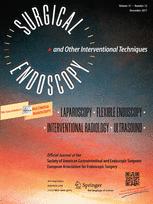Demyttenaere SV, Bergman S, Pham T, Anderson J, Dettorre R, Melvin WS, Mikami DJ
Surg Endosc. 2010 Apr; 24(4):854-8.
BACKGROUND:
EsophyX is an endolumenal approach to the treatment of gastroesophageal reflux disease (GERD). This report describes one of the earliest and largest North American experiences with this device.
METHODS:
Prospective data were gathered on consecutive patients undergoing EsophyX fundoplication for a 1-year period between September 2007 and March 2009. During this time, the procedure evolved to the current technique. A P value less than 0.05 was considered significant.
RESULTS:
The study enrolled 26 patients with a mean age of 45 years. The patients included 16 women (62%) with a mean body mass index (BMI) of 28 and an American Society Anesthesiology (ASA) classification of 2. These patients included 11 with associated small hiatal hernias, 3 with Barrett’s esophagus, and 5 with esophageal dysmotility. The procedure time was 65 min (range, 29-137 min), and the length of hospital stay was 1 day (range, 0-6 days). The postoperative valve circumference was 217 degrees, and the valve length was 2.7 cm. Two complications of postoperative bleed occurred, requiring transfusion. The mean follow-up period was 10 months. Comparison of pre- and postoperative Anvari scores (34-17; P = 0.002) and Velanovich scores (22-10; P = 0.0007) showed significant decreases. Although 68% of the patients were still taking antireflux medications, 21% had reduced their dose by half. Three patients had persistent symptoms requiring Nissen fundoplication, and there was one late death unrelated to the procedure.
CONCLUSION:
This study represents an initial single-institution experience with EsophyX. According to the findings, 53% of the patients had either discontinued their antireflux medication (32%) or had decreased their dose by half (21%). Both symptoms and health-related quality-of-life (HRQL) scores significantly improved after treatment. Further follow-up evaluation and objective testing are required.
Link to abstract on PubMed: Demyttenaere SV, et al; Surg Endosc. 2010 Apr; 24(4):854-8.


